PEDRO GÓMEZ-EGAÑA AND THE MANIFESTATION OF PERCEPTION
The MIT List Visual Arts Center presents The Great Learning, Pedro Gómez-Egaña’s exhibition that materializes our polyrhythmic experiences of time.
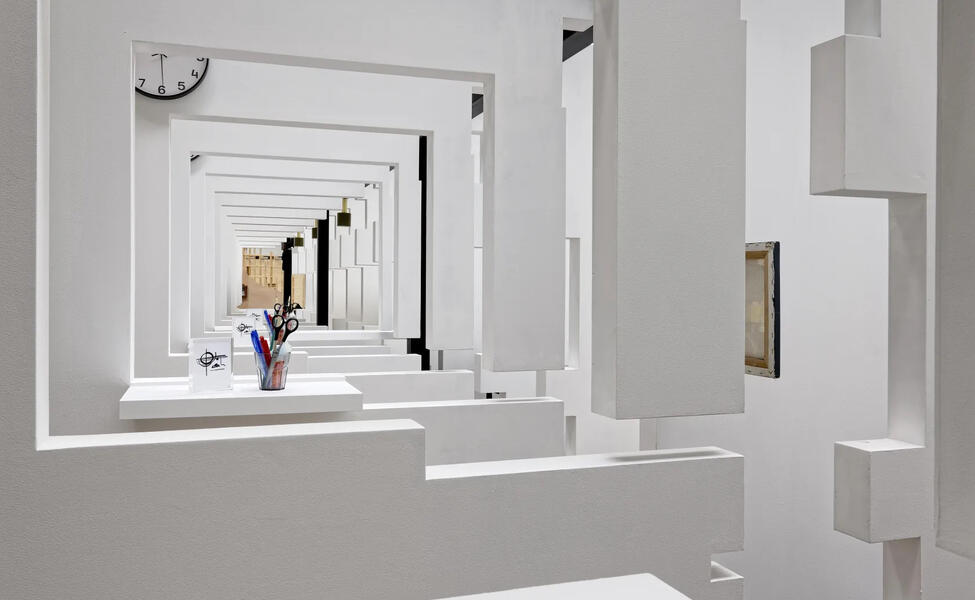
“We live in an age when contrasting temporalities coexist with an intensity that often feels irreconcilable,” the artist has said. “Media saturation, geological alteration, algorithmic immediacy, 24/7 labor culture, supply chain dynamics, and the relentless spectacle of political cycles” all condition how we make sense of the world.
In The Great Learning, Pedro Gómez-Egaña’s first solo museum exhibition in the U.S., architectural spaces are opened, multiplied, interrogated, and made to eclipse or dissolve. Objects are arranged in precise relationships, moving in ways that may evade perception, sometimes harnessing gravity or unexpected alignments. Visitors become spectators, listeners, and animating lenses as they navigate the space.
-
Pedro Gómez-Egaña, Virgo, 2022 (detail). Performative installation, dimensions variable. Photo: Blaise Adilon
-
Pedro Gómez-Egaña, Virgo, 2022 (detail). Performative installation, dimensions variable. Photo: Blaise Adilon
-
Pedro Gómez-Egaña, Virgo, 2022 (detail). Performative installation, dimensions variable. Photo: Blaise Adilon
-
Pedro Gómez-Egaña, Virgo, 2022 (detail). Performative installation, dimensions variable. Photo: Blaise Adilon
Organized by Natalie Bell, curator at MIT List Visual Arts Center, The Great Learning takes its title from a work by British composer Cornelius Cardew, drawing inspiration from his experimental work with The Scratch Orchestra, a group of non-musicians. Gómez-Egaña, trained as a musician and composer before turning to visual arts, similarly delegates aspects of the exhibition’s action to gallery attendants, the Orchestrators, who manipulate physical elements and the exhibition’s soundscape.
At the exhibition’s core, the large-scale installation Virgo (2022) contrasts different ways of experiencing and understanding time. Set-like reproductions of a domestic interior are divided by 28 walls, creating a mise-en-abyme effect. A visitor path cuts through diagonally, while two large steel frames, mounted on hidden wheels, are connected to furniture and objects that the Orchestrators move through precise gaps in the walls. Like frames in a film strip, each space within Virgo repeats with slight variations, and visitors act as animating agents, much like a projector’s mechanism brings still images to life, creating an illusion of movement and time. Cosmic rhythms are echoed in overhead lighting that simulates the sun’s movement throughout the day, casting drifting shadows that reward sustained attention.
In the adjacent gallery, a space saturated with red carpet and walls houses The Great Learning (2025), an unadorned copper rod suspended by microfilament threads that slowly falls to the ground over three hours, balanced by eleven counterweights. Nearby, steel pendulums (The Ask, 2025) knock against the walls, moved by gravity and hidden electromagnetic triggers. Deep Rivers (2025) appears as a nightstand embedded at an angle in the gallery’s seating.
When activated by the Orchestrators, a bellows-driven instrument within the work adds droning tones to Cordillera (2025), a minimalist sound piece blending Andean harmonies with everyday recordings from Oslo and Colombia. Together, these works create a haunting, immersive soundscape.
The Great Learning will be on view through July 27, 2025 at the MIT List Visual Arts Center, 20 Ames St., Cambridge, MA 02142 (United States).
Related Topics
May interest you
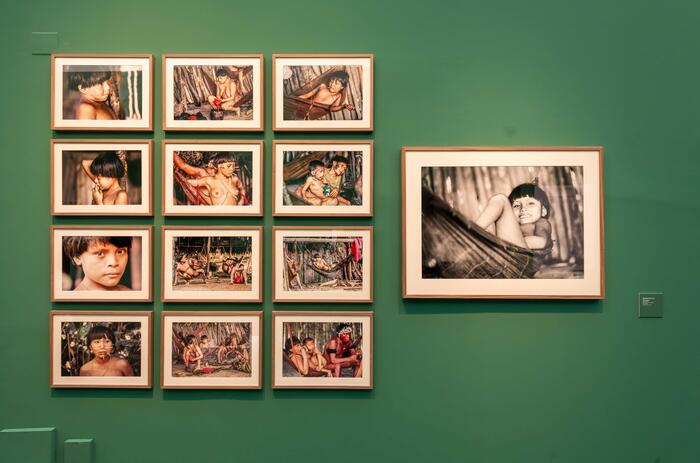
Madrid's CentroCentro approaches the artistic production related to the Amazon with the exhibition Trópico sin tópico: Amazonas (Tropic without Topic: Amazon), curated by Halim Badawi (Barranquilla, Colombia, 1982), and with which it intends to facilitate new looks beyond the usual ones with which the European imaginary contemplates the indigenous legacy and its relation with the contemporary world.
THE REVERSION OF AMAZONIAN CLICHÉS AT CENTROCENTRO
Madrid's CentroCentro approaches the artistic production related to the Amazon with the exhibition Trópico sin tópico: Amazonas (Tropic without Topic: Amazon), curated by Halim Badawi (Barranquilla, Colombia, 1982), and with which it intends to facilitate new looks beyond the usual ones with which the European imaginary contemplates the indigenous legacy and its relation with the contemporary world.

Madrid's CentroCentro approaches the artistic production related to the Amazon with the exhibition Trópico sin tópico: Amazonas (Tropic without Topic: Amazon), curated by Halim Badawi (Barranquilla, Colombia, 1982), and with which it intends to facilitate new looks beyond the usual ones with which the European imaginary contemplates the indigenous legacy and its relation with the contemporary world.
THE REVERSION OF AMAZONIAN CLICHÉS AT CENTROCENTRO
Madrid's CentroCentro approaches the artistic production related to the Amazon with the exhibition Trópico sin tópico: Amazonas (Tropic without Topic: Amazon), curated by Halim Badawi (Barranquilla, Colombia, 1982), and with which it intends to facilitate new looks beyond the usual ones with which the European imaginary contemplates the indigenous legacy and its relation with the contemporary world.
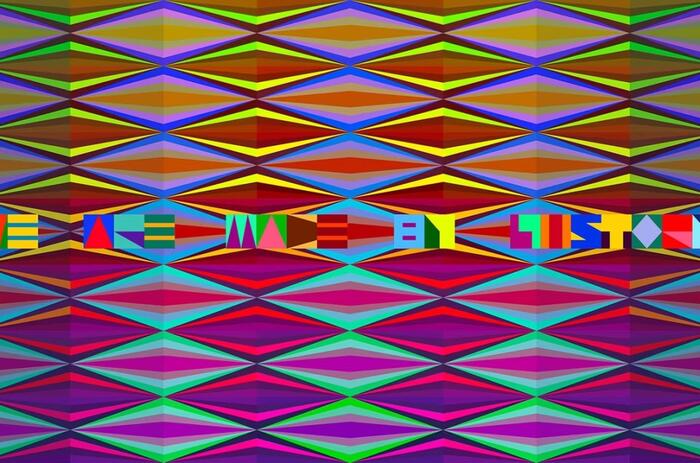
The Broad Museum is set to present Jeffrey Gibson: the space in which to place me, a special exhibition showcasing the artist’s multidimensional work. Adapted from its original presentation at the U.S. Pavilion at the 60th Biennale in 2024, this exhibition marks a historic moment—Gibson was the first Indigenous artist to represent the United States with a solo exhibition.
JEFFREY GIBSON IN LOS ANGELES: A KALEIDOSCOPE OF IDENTITY AND RESISTANCE
The Broad Museum is set to present Jeffrey Gibson: the space in which to place me, a special exhibition showcasing the artist’s multidimensional work. Adapted from its original presentation at the U.S. Pavilion at the 60th Biennale in 2024, this exhibition marks a historic moment—Gibson was the first Indigenous artist to represent the United States with a solo exhibition.
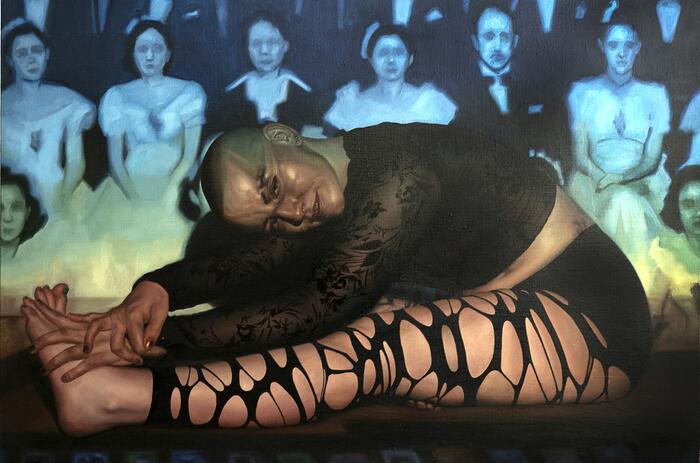
In her work, using traditional techniques such as oil painting, she explores contemporary imaginaries with a reflective approach to the relationship between memory, the body, image, and identity.
ELENA MANERO: PROJECTIONS OF THE UNGRASPABLE MEMORY
In her work, using traditional techniques such as oil painting, she explores contemporary imaginaries with a reflective approach to the relationship between memory, the body, image, and identity.

The Miriam and Ira D. Wallach Art Gallery at Columbia University presents Rubén Ortiz-Torres: Zonas de Colaboración, the artist’s first major solo exhibition in New York, curated by Betti-Sue Hertz.
RUBÉN ORTIZ-TORREZ AND THE CULTURAL PARADOXES OF THE GLOBALIZED WORLD
The Miriam and Ira D. Wallach Art Gallery at Columbia University presents Rubén Ortiz-Torres: Zonas de Colaboración, the artist’s first major solo exhibition in New York, curated by Betti-Sue Hertz.
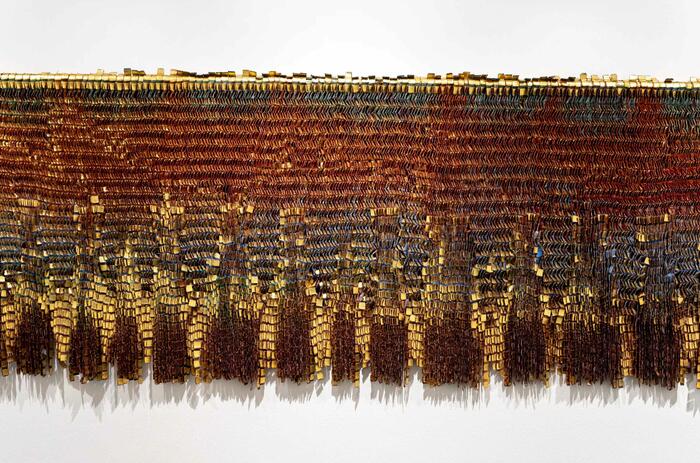
The Institute of Contemporary Art Miami (ICA Miami) presents a retrospective of textile artist Olga de Amaral (Bogotá, 1932), a pioneer in material exploration and the expansion of textile art. The exhibition, in collaboration with the Fondation Cartier pour l’art contemporain in Paris, will be open from May 1 to October 12, showcasing over 50 works spanning six decades of her career, including pieces never before exhibited outside Colombia.
AMARAL IN MIAMI: A JOURNEY THROUGH 60 YEARS OF ARTISTIC EVOLUTION
The Institute of Contemporary Art Miami (ICA Miami) presents a retrospective of textile artist Olga de Amaral (Bogotá, 1932), a pioneer in material exploration and the expansion of textile art. The exhibition, in collaboration with the Fondation Cartier pour l’art contemporain in Paris, will be open from May 1 to October 12, showcasing over 50 works spanning six decades of her career, including pieces never before exhibited outside Colombia.

Madrid's CentroCentro approaches the artistic production related to the Amazon with the exhibition Trópico sin tópico: Amazonas (Tropic without Topic: Amazon), curated by Halim Badawi (Barranquilla, Colombia, 1982), and with which it intends to facilitate new looks beyond the usual ones with which the European imaginary contemplates the indigenous legacy and its relation with the contemporary world.
THE REVERSION OF AMAZONIAN CLICHÉS AT CENTROCENTRO
Madrid's CentroCentro approaches the artistic production related to the Amazon with the exhibition Trópico sin tópico: Amazonas (Tropic without Topic: Amazon), curated by Halim Badawi (Barranquilla, Colombia, 1982), and with which it intends to facilitate new looks beyond the usual ones with which the European imaginary contemplates the indigenous legacy and its relation with the contemporary world.

The Broad Museum is set to present Jeffrey Gibson: the space in which to place me, a special exhibition showcasing the artist’s multidimensional work. Adapted from its original presentation at the U.S. Pavilion at the 60th Biennale in 2024, this exhibition marks a historic moment—Gibson was the first Indigenous artist to represent the United States with a solo exhibition.
JEFFREY GIBSON IN LOS ANGELES: A KALEIDOSCOPE OF IDENTITY AND RESISTANCE
The Broad Museum is set to present Jeffrey Gibson: the space in which to place me, a special exhibition showcasing the artist’s multidimensional work. Adapted from its original presentation at the U.S. Pavilion at the 60th Biennale in 2024, this exhibition marks a historic moment—Gibson was the first Indigenous artist to represent the United States with a solo exhibition.

In her work, using traditional techniques such as oil painting, she explores contemporary imaginaries with a reflective approach to the relationship between memory, the body, image, and identity.
ELENA MANERO: PROJECTIONS OF THE UNGRASPABLE MEMORY
In her work, using traditional techniques such as oil painting, she explores contemporary imaginaries with a reflective approach to the relationship between memory, the body, image, and identity.

The Miriam and Ira D. Wallach Art Gallery at Columbia University presents Rubén Ortiz-Torres: Zonas de Colaboración, the artist’s first major solo exhibition in New York, curated by Betti-Sue Hertz.
RUBÉN ORTIZ-TORREZ AND THE CULTURAL PARADOXES OF THE GLOBALIZED WORLD
The Miriam and Ira D. Wallach Art Gallery at Columbia University presents Rubén Ortiz-Torres: Zonas de Colaboración, the artist’s first major solo exhibition in New York, curated by Betti-Sue Hertz.

The Institute of Contemporary Art Miami (ICA Miami) presents a retrospective of textile artist Olga de Amaral (Bogotá, 1932), a pioneer in material exploration and the expansion of textile art. The exhibition, in collaboration with the Fondation Cartier pour l’art contemporain in Paris, will be open from May 1 to October 12, showcasing over 50 works spanning six decades of her career, including pieces never before exhibited outside Colombia.
AMARAL IN MIAMI: A JOURNEY THROUGH 60 YEARS OF ARTISTIC EVOLUTION
The Institute of Contemporary Art Miami (ICA Miami) presents a retrospective of textile artist Olga de Amaral (Bogotá, 1932), a pioneer in material exploration and the expansion of textile art. The exhibition, in collaboration with the Fondation Cartier pour l’art contemporain in Paris, will be open from May 1 to October 12, showcasing over 50 works spanning six decades of her career, including pieces never before exhibited outside Colombia.

Madrid's CentroCentro approaches the artistic production related to the Amazon with the exhibition Trópico sin tópico: Amazonas (Tropic without Topic: Amazon), curated by Halim Badawi (Barranquilla, Colombia, 1982), and with which it intends to facilitate new looks beyond the usual ones with which the European imaginary contemplates the indigenous legacy and its relation with the contemporary world.
THE REVERSION OF AMAZONIAN CLICHÉS AT CENTROCENTRO
Madrid's CentroCentro approaches the artistic production related to the Amazon with the exhibition Trópico sin tópico: Amazonas (Tropic without Topic: Amazon), curated by Halim Badawi (Barranquilla, Colombia, 1982), and with which it intends to facilitate new looks beyond the usual ones with which the European imaginary contemplates the indigenous legacy and its relation with the contemporary world.

The Broad Museum is set to present Jeffrey Gibson: the space in which to place me, a special exhibition showcasing the artist’s multidimensional work. Adapted from its original presentation at the U.S. Pavilion at the 60th Biennale in 2024, this exhibition marks a historic moment—Gibson was the first Indigenous artist to represent the United States with a solo exhibition.
JEFFREY GIBSON IN LOS ANGELES: A KALEIDOSCOPE OF IDENTITY AND RESISTANCE
The Broad Museum is set to present Jeffrey Gibson: the space in which to place me, a special exhibition showcasing the artist’s multidimensional work. Adapted from its original presentation at the U.S. Pavilion at the 60th Biennale in 2024, this exhibition marks a historic moment—Gibson was the first Indigenous artist to represent the United States with a solo exhibition.

In her work, using traditional techniques such as oil painting, she explores contemporary imaginaries with a reflective approach to the relationship between memory, the body, image, and identity.
ELENA MANERO: PROJECTIONS OF THE UNGRASPABLE MEMORY
In her work, using traditional techniques such as oil painting, she explores contemporary imaginaries with a reflective approach to the relationship between memory, the body, image, and identity.

The Miriam and Ira D. Wallach Art Gallery at Columbia University presents Rubén Ortiz-Torres: Zonas de Colaboración, the artist’s first major solo exhibition in New York, curated by Betti-Sue Hertz.
RUBÉN ORTIZ-TORREZ AND THE CULTURAL PARADOXES OF THE GLOBALIZED WORLD
The Miriam and Ira D. Wallach Art Gallery at Columbia University presents Rubén Ortiz-Torres: Zonas de Colaboración, the artist’s first major solo exhibition in New York, curated by Betti-Sue Hertz.

The Institute of Contemporary Art Miami (ICA Miami) presents a retrospective of textile artist Olga de Amaral (Bogotá, 1932), a pioneer in material exploration and the expansion of textile art. The exhibition, in collaboration with the Fondation Cartier pour l’art contemporain in Paris, will be open from May 1 to October 12, showcasing over 50 works spanning six decades of her career, including pieces never before exhibited outside Colombia.
AMARAL IN MIAMI: A JOURNEY THROUGH 60 YEARS OF ARTISTIC EVOLUTION
The Institute of Contemporary Art Miami (ICA Miami) presents a retrospective of textile artist Olga de Amaral (Bogotá, 1932), a pioneer in material exploration and the expansion of textile art. The exhibition, in collaboration with the Fondation Cartier pour l’art contemporain in Paris, will be open from May 1 to October 12, showcasing over 50 works spanning six decades of her career, including pieces never before exhibited outside Colombia.

Madrid's CentroCentro approaches the artistic production related to the Amazon with the exhibition Trópico sin tópico: Amazonas (Tropic without Topic: Amazon), curated by Halim Badawi (Barranquilla, Colombia, 1982), and with which it intends to facilitate new looks beyond the usual ones with which the European imaginary contemplates the indigenous legacy and its relation with the contemporary world.
THE REVERSION OF AMAZONIAN CLICHÉS AT CENTROCENTRO
Madrid's CentroCentro approaches the artistic production related to the Amazon with the exhibition Trópico sin tópico: Amazonas (Tropic without Topic: Amazon), curated by Halim Badawi (Barranquilla, Colombia, 1982), and with which it intends to facilitate new looks beyond the usual ones with which the European imaginary contemplates the indigenous legacy and its relation with the contemporary world.

The Broad Museum is set to present Jeffrey Gibson: the space in which to place me, a special exhibition showcasing the artist’s multidimensional work. Adapted from its original presentation at the U.S. Pavilion at the 60th Biennale in 2024, this exhibition marks a historic moment—Gibson was the first Indigenous artist to represent the United States with a solo exhibition.
JEFFREY GIBSON IN LOS ANGELES: A KALEIDOSCOPE OF IDENTITY AND RESISTANCE
The Broad Museum is set to present Jeffrey Gibson: the space in which to place me, a special exhibition showcasing the artist’s multidimensional work. Adapted from its original presentation at the U.S. Pavilion at the 60th Biennale in 2024, this exhibition marks a historic moment—Gibson was the first Indigenous artist to represent the United States with a solo exhibition.

In her work, using traditional techniques such as oil painting, she explores contemporary imaginaries with a reflective approach to the relationship between memory, the body, image, and identity.
ELENA MANERO: PROJECTIONS OF THE UNGRASPABLE MEMORY
In her work, using traditional techniques such as oil painting, she explores contemporary imaginaries with a reflective approach to the relationship between memory, the body, image, and identity.

The Miriam and Ira D. Wallach Art Gallery at Columbia University presents Rubén Ortiz-Torres: Zonas de Colaboración, the artist’s first major solo exhibition in New York, curated by Betti-Sue Hertz.
RUBÉN ORTIZ-TORREZ AND THE CULTURAL PARADOXES OF THE GLOBALIZED WORLD
The Miriam and Ira D. Wallach Art Gallery at Columbia University presents Rubén Ortiz-Torres: Zonas de Colaboración, the artist’s first major solo exhibition in New York, curated by Betti-Sue Hertz.

The Institute of Contemporary Art Miami (ICA Miami) presents a retrospective of textile artist Olga de Amaral (Bogotá, 1932), a pioneer in material exploration and the expansion of textile art. The exhibition, in collaboration with the Fondation Cartier pour l’art contemporain in Paris, will be open from May 1 to October 12, showcasing over 50 works spanning six decades of her career, including pieces never before exhibited outside Colombia.
AMARAL IN MIAMI: A JOURNEY THROUGH 60 YEARS OF ARTISTIC EVOLUTION
The Institute of Contemporary Art Miami (ICA Miami) presents a retrospective of textile artist Olga de Amaral (Bogotá, 1932), a pioneer in material exploration and the expansion of textile art. The exhibition, in collaboration with the Fondation Cartier pour l’art contemporain in Paris, will be open from May 1 to October 12, showcasing over 50 works spanning six decades of her career, including pieces never before exhibited outside Colombia.

Madrid's CentroCentro approaches the artistic production related to the Amazon with the exhibition Trópico sin tópico: Amazonas (Tropic without Topic: Amazon), curated by Halim Badawi (Barranquilla, Colombia, 1982), and with which it intends to facilitate new looks beyond the usual ones with which the European imaginary contemplates the indigenous legacy and its relation with the contemporary world.
THE REVERSION OF AMAZONIAN CLICHÉS AT CENTROCENTRO
Madrid's CentroCentro approaches the artistic production related to the Amazon with the exhibition Trópico sin tópico: Amazonas (Tropic without Topic: Amazon), curated by Halim Badawi (Barranquilla, Colombia, 1982), and with which it intends to facilitate new looks beyond the usual ones with which the European imaginary contemplates the indigenous legacy and its relation with the contemporary world.

The Broad Museum is set to present Jeffrey Gibson: the space in which to place me, a special exhibition showcasing the artist’s multidimensional work. Adapted from its original presentation at the U.S. Pavilion at the 60th Biennale in 2024, this exhibition marks a historic moment—Gibson was the first Indigenous artist to represent the United States with a solo exhibition.
JEFFREY GIBSON IN LOS ANGELES: A KALEIDOSCOPE OF IDENTITY AND RESISTANCE
The Broad Museum is set to present Jeffrey Gibson: the space in which to place me, a special exhibition showcasing the artist’s multidimensional work. Adapted from its original presentation at the U.S. Pavilion at the 60th Biennale in 2024, this exhibition marks a historic moment—Gibson was the first Indigenous artist to represent the United States with a solo exhibition.

In her work, using traditional techniques such as oil painting, she explores contemporary imaginaries with a reflective approach to the relationship between memory, the body, image, and identity.
ELENA MANERO: PROJECTIONS OF THE UNGRASPABLE MEMORY
In her work, using traditional techniques such as oil painting, she explores contemporary imaginaries with a reflective approach to the relationship between memory, the body, image, and identity.

The Miriam and Ira D. Wallach Art Gallery at Columbia University presents Rubén Ortiz-Torres: Zonas de Colaboración, the artist’s first major solo exhibition in New York, curated by Betti-Sue Hertz.
RUBÉN ORTIZ-TORREZ AND THE CULTURAL PARADOXES OF THE GLOBALIZED WORLD
The Miriam and Ira D. Wallach Art Gallery at Columbia University presents Rubén Ortiz-Torres: Zonas de Colaboración, the artist’s first major solo exhibition in New York, curated by Betti-Sue Hertz.

The Institute of Contemporary Art Miami (ICA Miami) presents a retrospective of textile artist Olga de Amaral (Bogotá, 1932), a pioneer in material exploration and the expansion of textile art. The exhibition, in collaboration with the Fondation Cartier pour l’art contemporain in Paris, will be open from May 1 to October 12, showcasing over 50 works spanning six decades of her career, including pieces never before exhibited outside Colombia.
AMARAL IN MIAMI: A JOURNEY THROUGH 60 YEARS OF ARTISTIC EVOLUTION
The Institute of Contemporary Art Miami (ICA Miami) presents a retrospective of textile artist Olga de Amaral (Bogotá, 1932), a pioneer in material exploration and the expansion of textile art. The exhibition, in collaboration with the Fondation Cartier pour l’art contemporain in Paris, will be open from May 1 to October 12, showcasing over 50 works spanning six decades of her career, including pieces never before exhibited outside Colombia.




